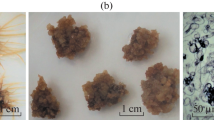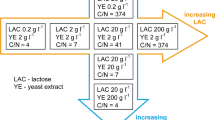Abstract
Changes in the content of the furostanol glycosides protodioscin and deltoside, particularly that of the (25S)-isomers of the glycosides, during suspension cultivation of different lines of Nepal yam (Dioscorea deltoidea Wall.) cells of the strain IFR-DM-0.5 has been investigated. The composition of furostanol glycosides has been characterized, and the dynamics of the accumulation of individual glycosides during lengthy subcultivation of cells maintained in flasks or in a barbotage bioreactor has been analyzed. A positive correlation between the growth and accumulation of substances that belonged to the class of furostanol glycosides has been demonstrated for cultured dioscorea cells, whereas the content of some of the individual glycosides varied considerably between the lines of the strain, cultures maintained under different conditions, and even between cells in different phases of the growth cycle. The increased content of (25R)-forms of the glycosides (protodioscin and deltoside) was correlated with a decrease in the cellular growth rate, whereas an increase in culture growth intensity occurred concomitantly to an increase of the amount of (25S)-isomers. This may be indicative of the specific stimulatory effect of (25S)-glycosides, but not the (25R)-forms, on cell proliferation in vitro. Thus, the concentration of (25S)-forms may increase due to the autoselection of cells capable of intensive division during prolonged cultivation.
Similar content being viewed by others
References
Nosov, A.M., Popova, E.V., and Kochkin, D.V., Production of Biomass and Bioactive Compounds Using Bioreactor Technology, Paek, K.-Y., Murthy, H.N., and Zhong, J.-J., Eds., Netherlands: Springer, 2014, pp. 563–623.
Vasil’eva, I.S. and Paseshnichenko, V.A., Usp. Biol. Khim., 2000, vol. 40, pp. 153–204.
Karanova, S.L., Shamina, Z.B., and Rappoport, I.A., Genetika, 1975, vol. 11, no. 1, pp. 35–40.
Butenko, R.G., Popov, A.S., Volkova, L.A., Chernyak, N.D., and Nosov, A.M., Plant Sci. Lett., 1984, vol. 33, no. 3, pp. 285–292.
Nosov, A.M., Paukov, V.N., and Butenko, R.G., Prikl. Biokhim. Mikrobiol., 1984, vol. 20, no. 1, pp. 125–129.
Titova, M.V., Shumilo, N.A., Kulichenko, I.E., Korostelev, V.V., Oreshnikov, A.V., and Nosov, A.M., Biotekhnologiya, 2006, no. 2, pp. 28–31.
Tarakanova, G.A., Paseshnichenko, V.A., Gudskov, N.L., and Butenko, R.G., Prikl. Biokhim. Mikrobiol., 1979, vol. 15, no. 1, pp. 106–111.
Butenko, R.G., Vorob’ev, A.S., and Nosov, A.M., Fiziol. Rast., 1992, vol. 39, no. 6, pp. 1146–1154.
Oreshnikov, A.V., Manakov, M.N., and Nosov, A.M., Fiziol. Rast., 1994, vol. 41, no. 6, pp. 518–528.
Kandarakov, O.F., Vorob’ev, A.S., and Nosov, A.M., Fiziol. Rast., 1994, vol. 41, no. 6, pp. 913–917.
Murashige, T. and Skoog, F., Physiol. Plant., 1962, vol. 15, no. 3, pp. 473–476.
Kaul, B. and Staba, J., Lloydia, 1968, vol. 31, no. 2, pp. 171–179.
Kochkin, D.V., Khandy, M.T., Zaitsev, G.P., Tolkacheva, N.V., Shashkov, A.S., Titova, M.V., Chirva, V.Ya., and Nosov, A.M., Khim. Prir. Soedin., 2016, no. 4, pp. 572–576.
Titova, M.V., Shumilo, N.A., Kulichenko, I.E., Ivanov, I.M., Sukhanova, E.S., and Nosov, A.M., Russ. J. Plant Physiol., 2015, vol. 62, no. 4, pp. 557–563.
Lambert, E., Faizal, A., and Geelen, D., Appl. Biochem. Biotechnol., 2011, vol. 164, no. 2, pp. 220–237.
Vasil’eva, I.S., Paseshnichenko, V.A., Urmantseva, V.V., Nosov, A.M., Chkheidze, E.G., and Bezzubov, A.A., Biokhimiya, 1990, vol. 55, no. 3, pp. 564–570.
Author information
Authors and Affiliations
Corresponding authors
Additional information
Original Russian Text © M.T. Khandy, M.V. Titova, S.V. Konstantinova, D.V. Kochkin, I.M. Ivanov, A.M. Nosov, 2016, published in Prikladnaya Biokhimiya i Mikrobiologiya, 2016, Vol. 52, No. 6, pp. 614–620.
Rights and permissions
About this article
Cite this article
Khandy, M.T., Titova, M.V., Konstantinova, S.V. et al. Formation of protodioscin and deltoside isomers in suspension cultures of Nepal yam (Dioscorea deltoidea Wall.) cells. Appl Biochem Microbiol 52, 657–662 (2016). https://doi.org/10.1134/S0003683816060077
Received:
Published:
Issue Date:
DOI: https://doi.org/10.1134/S0003683816060077




